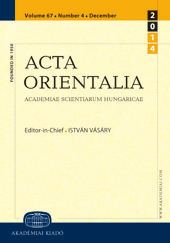From aesthetic rapture to servile love: the myth of the rasika in kālidāsa’s kumārasambhava
From aesthetic rapture to servile love: the myth of the rasika in kālidāsa’s kumārasambhava
Author(s): Ayal AmerSubject(s): Aesthetics, Other Language Literature, Theory of Literature
Published by: Akadémiai Kiadó
Keywords: Kumārasaṃbhava; Kālidāsa; Mahākāvya; rasika; aesthetic-erotic; love;
Summary/Abstract: This paper explores the aesthetic world of the Kumārasaṃbhava (The Birth of the Son) and probes its central theme of erotic love, perhaps one of the most important concerns of most kāvya poets. Using Robert Goodwin’s theoretical framework of the identification of the hero inside the Sanskrit Love Plays and the rasika connoisseur outside the play – or simply, the rasika myth – this paper sets out to explore the text as a psychological process rather than an aesthetic product. The central psychological element of the rasika myth is ‘love’, in its most sophisticated and naive manner: aesthetic- erotic love (śṛṅgārarasa) vis-à-vis love as an ordinary feeling (rati). The mythic paradigm thus emphasises the psychological tensions that surround kāvya’s aestheticism and its various representation of the notion of love. Clearly, the Kumārasaṃbhava depicts Śiva’s psychological reaction to the shifting status of a beautiful woman around him – from being the female Śrī of sexual allure of the first half of the poem to becoming the domesticated and devoted wife in the second half. Thus, by examining the central episode of the love story of Śiva and Pārvatī (cantos 3–5) from the rasika’s vantage point I argue that the Kumārasaṃbhava encodes a tension between the rasika’s keen obligation towards his subjective aesthetic emotions and his mandatory, emotional obligation toward socio-religious norms.
Journal: Acta Orientalia Academiae Scientiarum Hungaricae
- Issue Year: 66/2013
- Issue No: 2
- Page Range: 205-236
- Page Count: 32
- Language: English
- Content File-PDF

